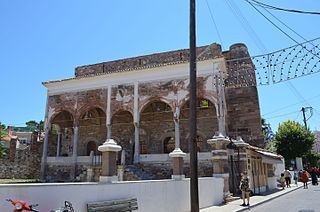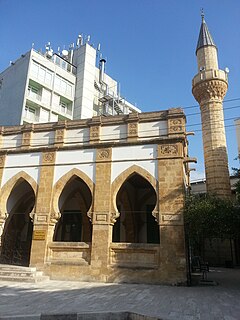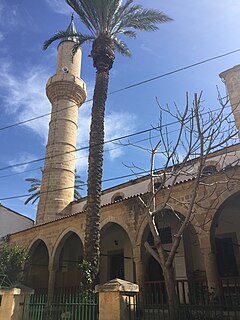
Eastern Rumelia was an autonomous territory in the Ottoman Empire, created in 1878 by the Treaty of Berlin and de facto ended in 1885, when it was united with the principality of Bulgaria, also under Ottoman suzerainty. It continued to be an Ottoman province de jure until 1908, when Bulgaria declared independence.

Islam in Bulgaria is a minority religion and the largest religion in the country after Christianity. According to the 2011 Census, the total number of Muslims in Bulgaria stood at 577,139, corresponding to 7.8% of the population. According to a 2017 estimate, Muslims make up 15% of the population. Ethnically, Muslims in Bulgaria are Turks, Bulgarians and Roma, living mainly in parts of northeastern Bulgaria and in the Rhodope Mountains.

Kırklareli is a city in the European part of Turkey.

Banya Bashi Mosque is a mosque in Sofia, Bulgaria.
The constitution provides for freedom of religion, and other laws and policies contributed to the generally free practice of religion. However, the constitution designates Eastern Orthodox Christianity as the "traditional" religion, exempting it from having to register in court as required for all other religious groups.

Sabancı Central Mosque in Adana is the largest mosque in Turkey. The exterior of the mosque is similar to the Selimiye Mosque in Edirne, though it has six minarets, similar to the Sultan Ahmed Mosque in Istanbul.

The Aziziye Mosque is a mosque in Stoke Newington, London. The mosque was funded by the UK Turkish Islamic Association and the conversion began in 1983. Turks who had once felt reluctant to attend a ‘non-Turkish’ mosque welcomed the congregation as services were provided in the Turkish language rather than in English or Arabic. The total capacity of its Ottoman style mosque is 2,000 people. The mosque also has a Halal butchers, Aziziye Education Centre, Aziziye Wedding hall and a restaurant.
A muftiate Bosnian: Muftijstvo or Muftiluk; Albanian: Myftini; Bulgarian: мюфтийство; Kazakh: мүфтият; Russian: Муфтият; Tatar: мөфтият; Romanian: muftiat; Ukrainian: Муфтіят) is an administrative territorial entity under the supervision of a mufti.

The Çelebi Sultan Mehmed Mosque, also known as the Bayezid Mosque and the Great Mosque, is an early 15th-century Ottoman mosque in Didymoteicho, East Macedonia and Thrace, in the far northeast of Greece.

Dzhumaya Mosque is located in Plovdiv, Plovdiv Province, Bulgaria. Its Turkish name is Hüdavendigâr Camii or Cuma Camii. The mosque is located in the centre of Plovdiv and was built in 1363–1364 on the site of the Sveta Petka Tarnovska Cathedral Church after the conquest of Plovdiv by the Ottoman army. During the reign of Sultan Murad I in the 15th century the old building was demolished and replaced by the modern-day mosque. It was called Ulu Dzhumaya Mosque, or Main Friday Mosque.

The Yeni Mosque is a historical Ottoman mosque in Mytilini on the island Lesbos of Greece.

Diyanet Center of America (DCA) is a non-profit organization based in Lanham, Maryland serving the needs of the Muslims in the Washington Metropolitan Area. The center holds regular Friday congregational prayers, Ramadan dinners, religious holiday celebrations and various other social, cultural, and religious activities.

Sarayönü Mosque, also known as the Mosque of the Serai, is a mosque in the walled city of Nicosia, Cyprus, currently located in North Nicosia. It is very close to the Sarayönü Square and has historically been on the square.
The following is a timeline of the history of the city of Plovdiv, Bulgaria.

Liberation Mosque, formerly the St Mary's Church Cathedral or Holy Mother of God Church, is located in the Tepebaşı district of Gaziantep in Turkey. It was built as an Armenian Apostolic Church but, after the Armenian Genocide, was converted into a mosque. Sarkis Balyan, the Ottoman-Armenian architect of Sultan Abdulhamid II, designed the church. Construction started in 1892, undertaken by the stonemason Sarkis Taşçıyan. The church was part of a complex that also contained a school and administrative buildings of the dioceses of the kaza of Antep.

Turunçlu Mosque, also known as Turunçlu Fethiye Mosque is a mosque in the Iplik Bazar–Korkut Effendi quarter in the walled city of Nicosia, currently located in North Nicosia. It dates to the Ottoman period. It is located on Beliğ Paşa Street.

Ömeriye Mosque, is a mosque in the walled city of Nicosia on the island of Cyprus, currently located in the south section of Nicosia. Following the Turkish invasion of Cyprus, the mosque gained significance as one of the most important sites of Muslim worship in the non-Muslim section of the island and the city.

Alaeddin Mosque, also known as Alaaddin Mosque is a historic mosque in Odunpazarı district of Eskişehir Province, Turkey.

Grand Mosque of Uşak is a historic mosque in Uşak, western Turkey.

Laleli Mosque is a mosque in the Abdi Çavuş quarter of the walled city of Nicosia, currently located in North Nicosia. It is located on Ali Ruhi Street. Its name, meaning "the Mosque with Tulips", is thought to be derived from the tulip motifs adorning its original minaret. Originally a small medieval chapel, it was enlarged and converted to a mosque in the 19th century.























